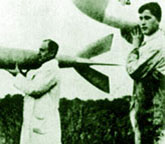Date: 22nd July
2007
Location: Workshop and pool
Conditions: Cool and sunny.
Rockets:
(click the name for rocket details)
|
Name |
Capacity |
Notes |
|
Acceleron IIIb |
24
L |
A newly rebuilt rocket after
Acceleron III exploded on the launch
pad during a full system test. |
|
Tachyon II |
2.5
L |
An upgraded sustainer that
provides better support during
liftoff. |
Team Members at
Event:
GK and PK
After a couple of weeks work, we have
rebuilt the Acceleron III
booster now designated Acceleron IIIb. During the rebuild we have also
made the following upgrades to it:
- All the neck to base couplings had
the lids replaced with the long threaded
lids. They now also have reinforcing
rings around them to stop them deforming
when they are tightened.
- All couplings have new seals.
- The inter bottle separating rings
have been replaced with continuous ones.
These are made from 2.25L bottles.
- The capacity of the booster was
decreased 0.75L because we used 2 L
bottles for all booster segments.
Acceleron III had three 2.25L bottles in
the stack.
- The nozzle lids have been
reinforced.
- The sustainer now is better
supported to withstand take-off forces.
- The sustainer fins have been
replaced by a different arrangement to
allow the sustainer to be supported by
the booster.
- The coupling holes in the bottles
have been heat treated to reduce the
risk of hairline cracks developing under
pressure.
- The flight software has been
upgraded to better reflect the state of
the computer.
Flight computer V1.4 details are now
available.
The rocket
gallery now includes a diagram with
descriptions of the
Acceleron IIIb booster components.
Burst Tests
We performed a number of burst tests to
get a sense of how these particular 2L bottles
perform. The results of these tests can be
found in the
burst test section results.
This time we tested the bottles under
water so that they wouldn't produce such a
big bang and any flying debris would also be
contained. The bottles being filled with
water and being submerged simply make a
relatively low thud and some bubbles. The
outside pressure of the water is less that
0.5psi so it really does not effect the
burst pressure.
We also tested two bottles coupled
together using the same coupling that
Acceleron III uses. One of the bottles burst
at around 165psi and it looks like the crack
propagated from the bottle outside diameter
to the coupling hole. This then fanned out
in multiple directions from the hole. One
thing it did teach us about the coupling is
that it can hold up the burst pressure of
the bottles.
A while back while
testing
reinforcing of bottles the Gardena
nozzle attachment kept flying off and so for
these tests we made a permanent connection
to the lid. The lid was also secured with a
pipe clamp.
The upshot of the tests is that we will
be pressurising only to 110psi instead of
the 120psi as originally planned. Although
120psi is still feasible, the first flights
will be at the lower pressure. Once we have
a few good flights under our belt, we may
increase the pressure a little, and later we
will have a go at reinforcing the bottles.
Parachute
We have also finished making the
parachute. Originally we wanted to make the
parachute from a flat hexagonal sheet of
Ripstop nylon. We even bought the material
and cut it out, but decided to go with the
material from one of those large golf
umbrellas instead. The shape is more correct
for a parachute than a flat sheet, and it
has already been properly edged. I actually
found it on the way home on the side of the
road still attached to a destroyed umbrella,
after the last set of Sydney storms. The
parachute is 1500mm in diameter and weighs
120
grams.
We sewed reinforcing ribbon to the shroud
line attachment points and used some heat
shrink tubing over the knots to stop them
from unravelling. There are two main
parachute lines for redundancy, should one
of them snap during a deploy, the other
should still bring the booster to a gentler
landing, although at a less optimal
attitude. The booster is designed to fall
sideways under the parachute to increase the
drag of the rocket on the way down.
Miscellaneous
- I called the
local manufacturer
of the 2L bottles to
see if I could by a small batch but they
said they do not deal with orders smaller
than 100,000! But they suggested I call the
local distributor. They said they can do
smaller lots, but only by the palette which
contained just over 500 bottles at 38c each.
That was still a little too much so we are
just buying them off the shelf in a
supermarket. Aldi sells them for 99c each
with lemonade. Franklins sells them for
$1.09.
- We have also tested mounting the hand
held DV camera to a
wooden boom to steady it when filming
zoomed in at a distance. Since a tripod
makes it very difficult to track a rocket
quickly, the shoulder mounted boom seemed to do a reasonable
job at reducing the shake. We will make
slight adjustments to it and we will use it
to film the sustainer at a distance.
- The sustainer's removable fin assembly
has been removed (now being used on a new
rocket under construction) and was
replaced by a new skirt that helps support
the sustainer during takeoff. The fins are
permanently attached to the skirt. For
strength the skirt is glued to the
sustainer body with PL premium.
- There are still a few minor things to
finish and we should be able to do all the tests
again very soon. And hopefully fly as soon
as possible after that.
|























